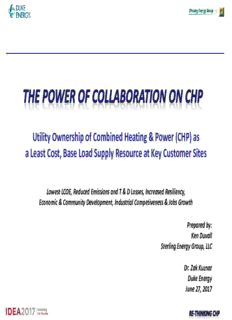Table Of ContentUtility Ownership of Combined Heating & Power (CHP) as
a Least Cost, Base Load Supply Resource at Key Customer Sites
Lowest LCOE, Reduced Emissions and T & D Losses, Increased Resiliency,
Economic & Community Development, Industrial Competiveness & Jobs Growth
Prepared by:
Ken Duvall
Sterling Energy Group, LLC
Dr. Zak Kuznar
Duke Energy
June 27, 2017
Four Brief Segments for Today’s Discussion
1) Recap Fast Facts – the Rapidly Changing Energy
Industry and implications for 21st century grid
2) Rethinking CHP – as a Collaborative Base Load
Supply Resource
Overcoming traditional Impediments
Benefits to Utility, Host, All Customers, Community
Clemson University / Duke Energy 16 MW CHP
Under Development –Clemson, SC 3) Review of Utility Planning Methodology &
Ownership Model for CHP
4) Overview Case Studies & Review of Benefits
Clemson University, Duke Energy CHP under
Development
Duke University, Duke Energy CHP Development
Eight Flags Energy CHP, Florida Public Utilities at
-
Rayonier Advanced Materials Amelia Island, FL
operating
FPU / Eight Flags Energy 22 MW CHP
at Rayonier Advanced Materials, Amelia Island, FL
2
In Case You Haven’t Noticed . . . The Industry is Changing
Source: Duke Energy’s 2017 graphic representing the historic and current evolution of the Energy Industry
3
Electric Industry is in Midst of Biggest Transition of past Century . . .
• From More Centralized to More Decentralized
• From Steady High Load Growth to Uncertain Low, even No Growth
• From Coal and Nuclear based to Natural Gas and Renewable based
• From analog, one-way flow, to Digital, multi-directional flow
• From Fuel Driven to Increasing penetration of Intermittent
resources
• From “Nothing we can do about outages” to “We can offer
uninterrupted power supply”
• From this is your tariff, to what kind of tariff do you want?
And . . .
• From Cogeneration not Allowed (without jumping through costly
hurdles), to Would you like to be Our Thermal Host Partner to
Build CHP with you
4
Context Matters: Fast Facts About the Electric Industry . . .
• The “Grid” is only about 35-38% Efficient
Two Thirds of fuel input energy is lost in conversion and delivery (exhausted into
atmosphere as waste heat and emissions)
• Gas Turbine Combined Cycle plants have become the Backbone of base load power
as Coal and Nuclear Retirements continue
GTCC maximum efficiency is 55% HHV and fleet average is ~ 50% while typical
coal fired plant efficiency is about 35%
T&D losses in US average 7% but can double during hottest peak hours
• Wind and Solar PV are by far the fastest growing capacity resource, Still . . .
• Fossil fuels will supply over 50% of all electricity produced in the US beyond 2050,
RE peaks @ 29%
Current EIA Jan 2017 reference case, no CPP, fossil fuel will supply 60% 2050
Under either scenario, latest DOE/EIA forecast indicates well over half of
electricity production will be fossil fuel based in 2050
5
Natural Gas CC only about 50% efficient, Coal about 35%
• Over 60% Fuel input to produce
electricity is lost in conversion and
delivery (waste heat & emissions)
• The most efficient, base load plant on
the grid today is GT CC @ ~50%
• T&D losses average 7-8% but I2R
losses can double in peak hours
Minooka Combined Cycle Power Plant Minooka, Illinois
6
Grid Efficiency Has Seen Very Little Improvement in Decades
Gas Turbine Combined Cycle
under 50% efficient
Introduction of Gas Fired
Combined Cycle moves
efficiency to 50%
Coal fired generation
Approximately 35% efficient
Coal Fired Generation
Almost flat at 33-35% efficiency
for decades
7
Source: https://www.wec-indicators.enerdata.eu/power-plants-thermals.html#/coal-fired-power-plants-efficiency.html
FAST FACTS -- Over 50% Electricity from fossil fuels past 2050
DOE electricity forecast below is with CPP
• While RE (wind and Solar/PV) are by far the fastest growing capacity
resources, the Grid will continue to be dependent on fossil fuels well
past mid-century for base load & peaking energy – even in California
US DOE AEO - January 2017 Reference Case Forecast with CPP
8
Given the Industry Transition . . .
Re-thinking means answering these and other questions
• Why Have Utilities Traditionally Viewed CHP as a Competitive Resource?
• How does CHP compare with Gas Combined Cycle and Other Base Load & RE
Utility Supply Resources ?
Levelized Cost of Energy?
What Other Benefits are Available with CHP?
• Of the 82,000 MW CHP Installed Why do Utilities only own 2-3%?
How Can we Capture the Enormous Untapped Efficiency Potential of
150,000 MW Undeveloped CHP at Sites > 5MW
• CHP uses Natural Gas – How does CHP Emissions Compare with Other
Resources ?
Coal, Gas SC, Gas CC, Wind and Solar PV
• How do the Risks of Building CHP Compare with Other Resources?
9
Fast Facts About Combined Heating & Power
Properly Applied CHP is the Most Efficient Method of Generating
Power on the Planet – Can achieve delivered efficiency of 75-80% HHV
• 50% more efficient than next best grid resource & lowest levelized cost of energy
(LCOE) among any resource
• CHP is based upon long proven GT/HRSG equipment (same as CC)
There is no technology curve to get up or cost curve to get down
• In addition to superior efficiency, CHP provides many additional benefits
Unloads Grid, Reduces Congestion and reduces T&D losses – supports higher
penetrations of RE
Increased Resiliency from grid disturbances in our digital economy
Significantly reduces emissions and water use per MWh
Lowers Investment Risk / Must Faster Planning, Permitting & implementation
• And, CHP produces benefits on both sides of the meter
Lowers costs, Increased competitiveness for host /Customer
Increased local tax base, economic development & jobs
10
Description:Unfamiliarity with technology and O&M risks. ▫ Interconnection and Regulatory hurdles. ▫ Utility Tariff policies. • 82,000 MW of CHP in the US, but DOE Studies confirm over 150,000 MW undeveloped CHP potential remain of 5MW and larger sites. • Can supply base load power at efficiencies up t

